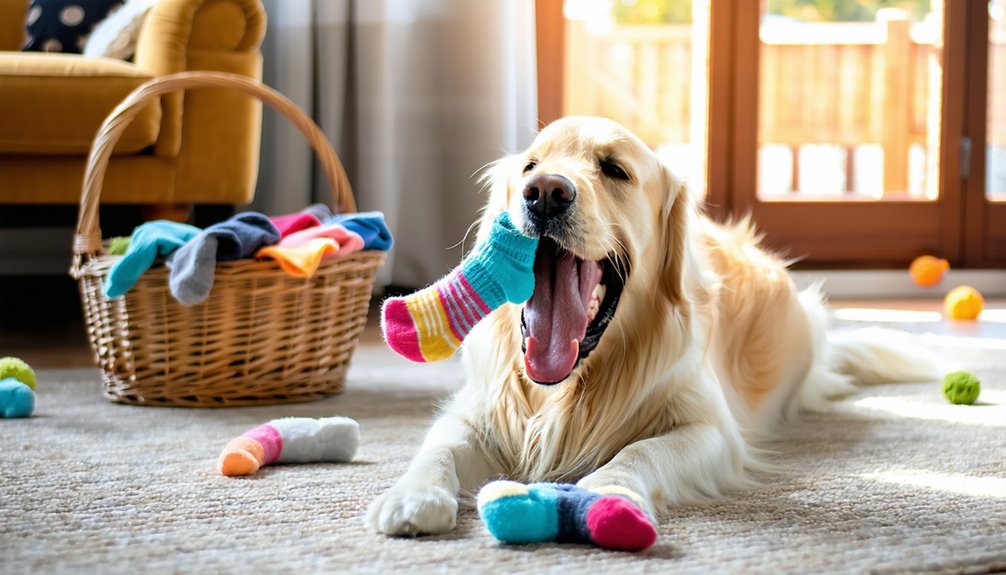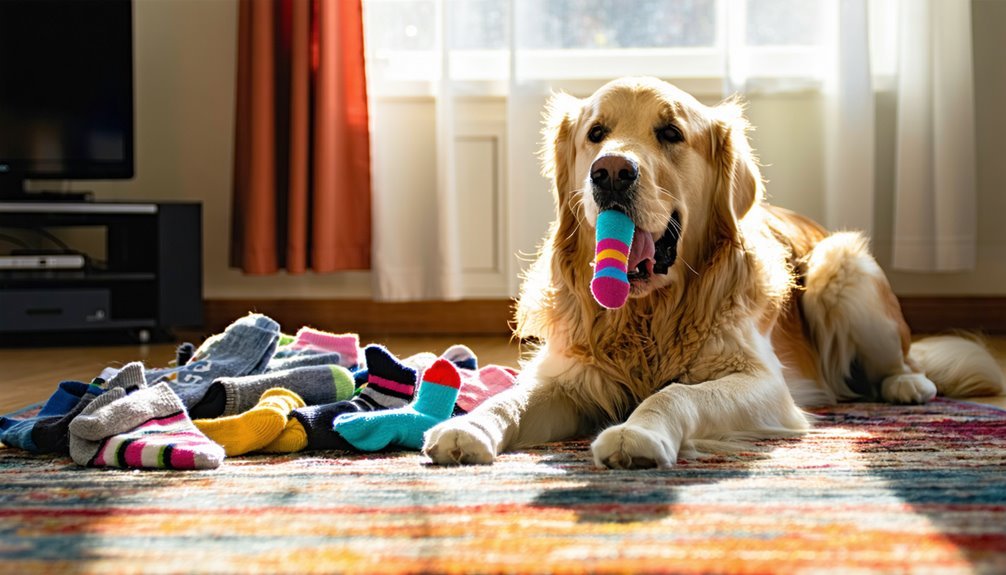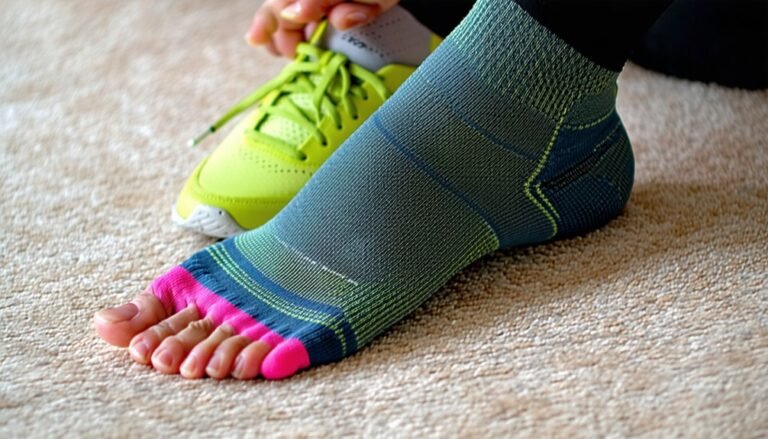Why Does My Dog Eat Random Socks
Your dog may eat random socks due to their natural scavenging instincts, as they find the texture and scent intriguing. Socks can offer comfort, especially if they carry your scent. If your dog is bored or anxious, chewing can serve as a coping mechanism. Additionally, nutritional deficiencies might drive them to seek unconventional items. Understanding these factors can help you manage this behavior effectively. Explore further to find strategies that can curb this sock munching habit.
Understanding Canine Instincts

While it may seem puzzling when your dog decides to munch on a sock, understanding their instincts can shed light on this behavior. Canine behavior often reflects instinctual habits inherited from their ancestors. Dogs are natural scavengers and may view socks as intriguing items to explore. The texture and scent can stimulate their curiosity, prompting them to chew or play with these objects. Additionally, your dog might also associate socks with your scent, providing comfort and security. This instinctual behavior can be further amplified if they're feeling anxious or seeking attention. Recognizing these natural tendencies is essential for ensuring your pet's safety and well-being, as consuming inappropriate items can lead to health issues.
The Role of Boredom in Sock Eating
Boredom can be a significant factor in why dogs resort to eating socks. When your dog lacks sufficient mental stimulation, they may seek out alternative activities, such as chewing on your belongings. Boredom signs can include excessive barking, digging, or destructive behavior. These behaviors indicate that your dog is seeking something to engage their mind and alleviate their boredom. To counter this, it is crucial to provide regular mental stimulation through interactive toys, training sessions, or daily exercise. Engaging your dog in fun activities not only keeps them entertained but also reduces the likelihood of sock-eating behaviors. By addressing boredom proactively, you create a more fulfilling environment for your dog, ultimately enhancing their well-being and reducing unwanted habits.
Anxiety and Stress Factors
When your dog exhibits anxiety, it can manifest in various behaviors, including sock chewing. Factors like separation anxiety and stressful environments may lead them to seek comfort in items that carry your scent. Understanding these triggers and coping mechanisms can help you address the underlying issues effectively.
Separation Anxiety Symptoms
As your dog becomes increasingly anxious when left alone, you might notice a range of symptoms that indicate separation anxiety. Recognizing these signs early can help you implement effective separation techniques and seek anxiety relief for your pet.
- Excessive barking or howling
- Destructive behavior, such as chewing furniture or shoes
- Frequent pacing around the house
- Attempts to escape, like digging or scratching at doors
- Loss of appetite or reluctance to play
Addressing these symptoms is essential for your dog's well-being. By understanding these behaviors, you can take proactive measures to create a more comfortable environment and reduce their stress. Remember, the sooner you identify these signs, the better equipped you'll be to support your furry companion.
Stress-Inducing Environments
Creating a calm environment is essential for reducing your dog's anxiety levels. Stress triggers can arise from various environmental changes, such as moving to a new home, introducing new pets, or even alterations in your daily routine. Dogs are sensitive to their surroundings, and disruptions can lead to feelings of insecurity and stress. Identifying these stress triggers is vital; it allows you to mitigate their impact. For instance, if loud noises are distressing for your dog, consider using soundproofing techniques or playing soothing music. Providing a safe space where your dog can retreat during stressful times is equally important. By fostering a secure environment, you can help alleviate anxiety, ultimately reducing the likelihood of behaviors like sock eating as a coping mechanism.
Coping Mechanisms in Dogs
Although dogs may not articulate their feelings, they exhibit various coping mechanisms to manage anxiety and stress. Understanding these behaviors can help you implement effective coping strategies and behavioral modification techniques. Recognizing your dog's signals is essential for their well-being.
- Chewing on objects, like socks, as a self-soothing activity
- Excessive barking or whining when anxious
- Seeking comfort in familiar spaces or toys
- Engaging in repetitive movements, like pacing
- Changes in appetite or sleeping patterns
Identifying these signs allows you to create a safer environment. Consider consulting a veterinarian or animal behaviorist to discuss tailored strategies for addressing your dog's anxiety. This proactive approach can greatly enhance your pet's quality of life and strengthen your bond.
Nutritional Deficiencies and Dietary Needs

When dogs experience nutritional deficiencies, they often seek out unconventional items like socks to fulfill their dietary needs. This behavior may indicate an imbalance in their nutrition, prompting them to look for alternative sources of nutrients. It's vital to guarantee your dog's diet maintains a proper nutritional balance, as deficiencies can lead to health issues. Incorporating high-quality dog food that meets their specific needs is important. Additionally, consider discussing dietary supplements with your veterinarian to address any gaps. These supplements can help provide necessary vitamins and minerals that may be lacking in their regular diet, reducing the likelihood of sock consumption and promoting overall well-being. Always prioritize your dog's nutritional health to prevent such behaviors.
The Appeal of Texture and Smell
When you observe your dog with a sock, consider how their sensory exploration behavior drives this action. The unique texture and familiar human scents of your socks create an irresistible combination for them. This interaction not only satisfies their curiosity but also provides comfort through the association with you.
Sensory Exploration Behavior
Why do dogs find socks so irresistible? It often boils down to sensory exploration behavior. Dogs are naturally curious and engage in exploratory behavior to stimulate their senses. Socks offer a unique combination of texture and scent, which can provide significant sensory stimulation. This behavior can be harmless, but it's crucial to understand why it occurs.
Here are some reasons socks captivate your dog:
- Varied textures: Different fabrics provide interesting tactile experiences.
- Intriguing smells: Socks often carry your scent, enticing your dog further.
- Comfort and security: Familiar items can offer a sense of comfort.
- Novelty: Dogs enjoy the challenge of exploring new items.
- Boredom relief: Chewing on socks can alleviate boredom.
Understanding this behavior helps guarantee your dog remains safe.
Familiar Human Scents
Socks not only provide varied textures that engage a dog's exploratory instincts but also carry the familiar scents of their human companions. These familiar scents act as comfort objects, evoking feelings of safety and security for your dog. When they sniff or chew on your socks, they're not just indulging in a physical sensation; they're also connecting with you emotionally. This behavior can be particularly common in anxious or young dogs who seek reassurance. By understanding this connection, you can redirect their attention to safer alternatives, like designated chew toys that also carry your scent. Ensuring your dog has access to these appropriate comfort objects helps promote their well-being while keeping your belongings safe from potential damage.
Attention-Seeking Behavior
Although many dog owners might find their pets' sock-eating habits amusing, it is essential to recognize that this behavior can often stem from a desire for attention. When you react to your dog's actions, even negatively, you're providing attention cues that reinforce the behavior, leading to a cycle of attention-seeking. To address this issue effectively, consider the following strategies:
- Redirect their focus to a toy or bone.
- Offer regular mental and physical stimulation.
- Establish a consistent routine for playtime.
- Ignore unwanted behavior while reinforcing positive actions.
- Consult a professional trainer if the behavior persists.
The Influence of Playfulness
Playfulness plays a significant role in a dog's behavior, including their tendency to chew on socks. When dogs engage in playful exploration, they often use their mouths to investigate objects around them. This instinctual behavior is part of their natural curiosity and desire to interact with their environment. Socks, being soft and malleable, may seem like an appealing target for their playful antics. While this behavior can be amusing, it is crucial to remember that it can lead to potential hazards, such as choking or digestive issues. Understanding this connection between playfulness and sock chewing helps you appreciate your dog's instincts, while also highlighting the importance of providing safe, appropriate items for them to explore and chew on.
Strategies to Curb Sock Munching

To effectively curb your dog's sock munching habits, it is essential to implement a combination of preventive measures and positive reinforcement techniques. Here are some strategies to bear in mind:
- Provide sock alternatives: Offer safe chew toys or fabric items designed for dogs.
- Consistent training techniques: Use commands like "leave it" to discourage sock theft.
- Environmental management: Keep socks out of reach by storing them in closed drawers.
- Redirect attention: If you catch your dog with a sock, redirect them to a toy.
- Reward good behavior: Praise or treat your dog when they choose toys over socks.
Frequently Asked Questions
Can Certain Dog Breeds Be More Prone to Sock Eating?
Certain dog breeds do exhibit behavioral tendencies that might make them more inclined to chew or eat socks. Understanding these breed tendencies and their behavior patterns can help you manage this potentially harmful habit effectively.
What Are the Health Risks of Dogs Eating Socks?
Around 15% of dogs experience digestive blockages from foreign objects. Sock ingestion can lead to severe complications, including intestinal obstruction, which may require surgery. It's essential to monitor your dog's behavior and prevent access to socks.
How Can I Safely Remove Socks From My Dog's Mouth?
To safely remove socks from your dog's mouth, use mouth techniques like gently opening their jaw. Employ removal methods such as distraction with treats or toys, ensuring you remain calm to prevent anxiety during the process.
Are There Alternative Toys to Prevent Sock Chewing?
If you want to save your socks from becoming dog chew toys, consider interactive toys or chew alternatives. These options engage your pup's mind and satisfy their urge to chew, promoting safer habits.
Is Sock Eating a Sign of a More Serious Behavioral Issue?
Sock eating can indicate underlying anxiety triggers or a sock obsession. If your dog compulsively chews or consumes socks, it's important to assess their behavior and consult a veterinarian for potential behavioral or health issues.







